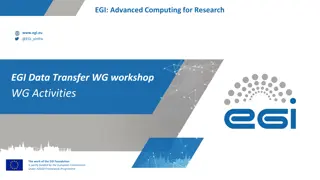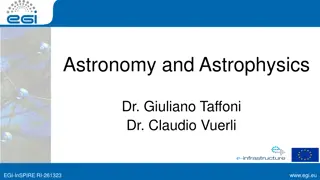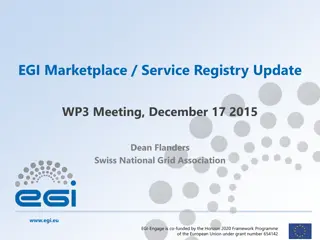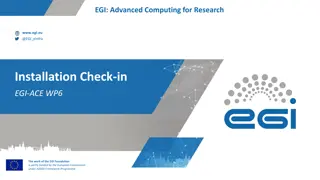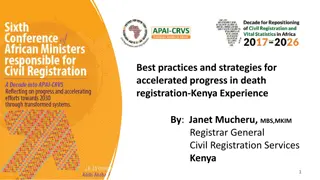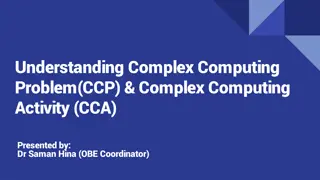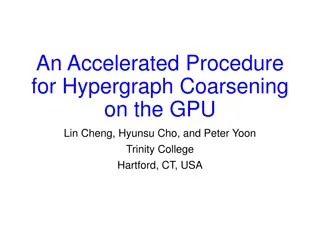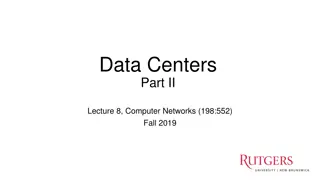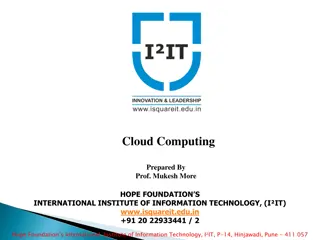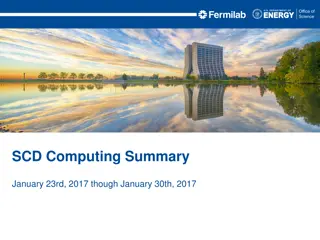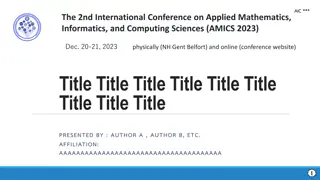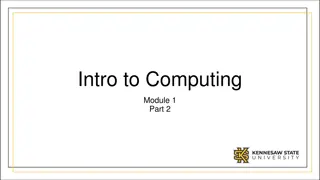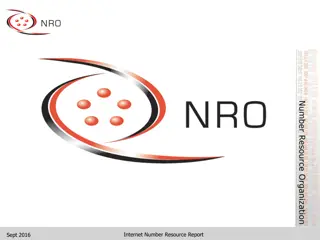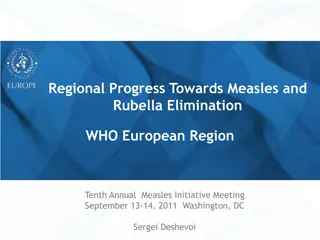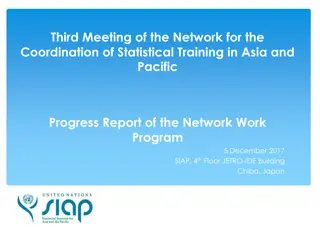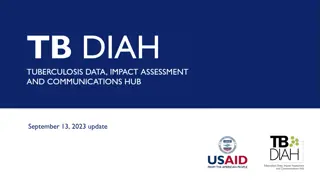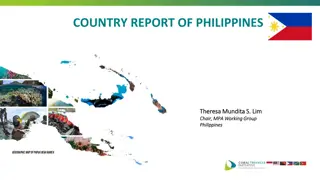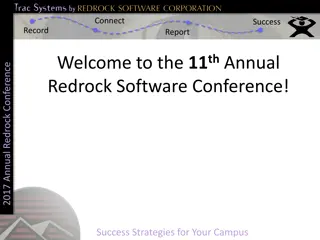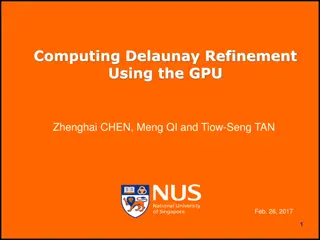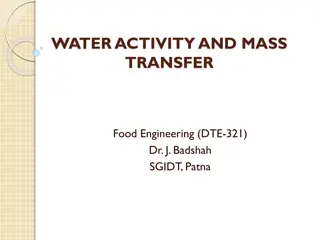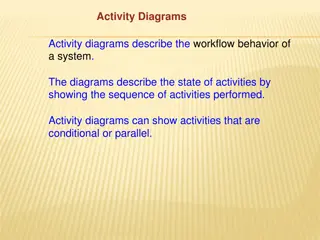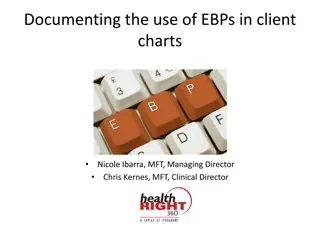Accelerated Computing Activity Progress Report at EGI Conference 2016
This report outlines the progress made in implementing a new accelerated computing platform as part of the EGI-Engage JRA2 project. The project aimed to support GPGPU integration in batch systems and disciplines like structural biology and molecular dynamics. Key performance indicators and work plans are discussed, highlighting advancements in accelerated computing in grid systems. The report also covers collaborations with partner institutions and provides links to previous sessions and additional resources.
Download Presentation

Please find below an Image/Link to download the presentation.
The content on the website is provided AS IS for your information and personal use only. It may not be sold, licensed, or shared on other websites without obtaining consent from the author. Download presentation by click this link. If you encounter any issues during the download, it is possible that the publisher has removed the file from their server.
E N D
Presentation Transcript
Accelerated Computing activity progress report Marco Verlato (INFN) Viet Tran (IISAS) EGI Conference 2016 6-8 April, Amsterdam www.egi.eu EGI-Engage is co-funded by the Horizon 2020 Framework Programme of the European Union under grant number 654142
Introduction/1 Task part of EGI-Engage JRA2: Platforms for the Data Commons To provide a new accelerated computing platform by: implementing the support in the information system (based on OGF GLUE standard) extending the HTC and cloud middleware support for co-processors Duration: 1stMarch 2015 31stMay 2016 (15 Months) Partners: INFN: CREAM-CE developers at Padua and Milan divisions IISAS: Institute of Informatics, Slovak Academy of Sciences CIRMMP: Scientific partner of MoBrain CC (and WeNMR/West-Life, INDIGO-DataCloud H2020 projects) EGI Conference 2016, 6-8 April, Amsterdam 9/21/2024 2
Introduction/2 Key performance indicators: Target1stY Target2ndY metric Description Number of batch systemsfor which GPGPU integration is supported through CREAM MJRA2.AC.1 1 (Torque/Maui) 3 (Torque/Maui, Slurm, HTCondor) Number of CMF for which GPGPU integration is supported MJRA2.AC.2 1 (OpenStack) 2 (OpenStack, OpenNebula) Number of disciplines with user applications supported 2 (structural biology, molecular dynamics) 3 (structural biology, molecular dynamics, biodiversity) MJRA2.AC.3 Ideally divided in two subtasks: Accelerated computing in Grid (=HTC platform) Accelerated computing in Cloud Previous sessions: http://bit.ly/Lisbon-GPU-Session http://bit.ly/Bari-GPU-Session EGI Conference 2016, 6-8 April, Amsterdam 9/21/2024 3
Accelerated Computing in Grid www.egi.eu EGI-Engage is co-funded by the Horizon 2020 Framework Programme of the European Union under grant number 654142
Accelerated computing in Grid The problem: CREAM-CE is the most popular grid interface (Computing Element) to a number of LRMSes (Torque, LSF, Slurm, SGE, HTCondor) since many years in EGI Most recent versions of these LRMSes do support natively GPGPUs (or MIC cards), i.e. servers hosting these cards can be selected by specifying LRMS directives CREAM must be enabled to publish this information and support these directives Work plan Indentifying the relevant GPGPU-related parameters supported by the different LRMS, and abstract them to significant JDL attributes Implementing the needed changes in CREAM-core and BLAH components Writing the info-providers according to GLUE 2.1 Testing and certification of the prototype Releasing a CREAM update with full GPGPU support Progresses recorded in https://wiki.egi.eu/wiki/GPGPU-CREAM EGI Conference 2016, 6-8 April, Amsterdam 9/21/2024 5
News after Bari/1 CIRMMP testbed used for MoBrain applications AMBER, Powerfit and DisVis applications with CUDA 5.5 3 nodes (2x Intel Xeon E5-2620v2) with 2 NVIDIA Tesla K20m GPUs per node Torque 4.2.10 (source compiled with NVML libs) + Maui 3.3.1 EMI3 GPU-enabled CREAM-CE prototype Example of JDL for DisVis (see https://wiki.egi.eu/wiki/CC-MoBrain): $ glite-ce-job-submit -o jobid.txt -d -a r cegpu.cerm.unifi.it:8443/cream-pbs-batch disvis.jdl $ cat disvis.jdl [ executable = "disvis.sh"; inputSandbox = { "disvis.sh" ,"O14250.pdb" , "Q9UT97.pdb" , "restraints.dat" }; stdoutput = "out.out"; outputsandboxbasedesturi = "gsiftp://localhost"; stderror = "err.err"; outputsandbox = { "out.out" , "err.err" , "res-gpu.tgz"}; GPUNumber=2; ] Deliverable D6.7 to be published soon EGI Conference 2016, 6-8 April, Amsterdam 9/21/2024 6
AMBER on GPU-enabled grid testbed MD simulations with AMBER: a) Restrained Energy Minimization on NMR Structures b) Free MD simulations of ferritin a) ~100x gain 8 7 Simulation performance (ns/day) Opteron 6366HE Xeon E5-2620 Tesla K20 6 5 4 b) 3 2 WeNMR/AMBER grid portal can now exploit GPU resources 1 0 0 10 20 30 Cores 40 50 60 EGI Conference 2016, 6-8 April, Amsterdam 9/21/2024 7
News after Bari/2 Static info-provider based on GLUE2.1 ExecutionEnvironment class deployed at CIRMMP testbed: $ ldapsearch -LLL -x -h cegpu.cerm.unifi.it -p 2170 -b o=glue | grep GPU GLUE2ExecutionEnvironmentGPUClockSpeed: 706 GLUE2ExecutionEnvironmentGPUModel: Tesla K20m GLUE2ExecutionEnvironmentGPUVendor: NVIDIA GLUE2ExecutionEnvironmentPhysicalGPUs: 6 GLUE2ExecutionEnvironmentLogicalGPUs: 14976 Dynamic info-providers need new attributes in GLUE2.1 draft: ComputingManager class (the LRMS) TotalPhysicalGPUs, TotalGPUSlots, UsedGPUSlots ComputingShare class (the batch queue) FreeGPUSlots, UsedGPUSlots EGI Conference 2016, 6-8 April, Amsterdam 9/21/2024 8
News after Bari/3 CIRMMP testbed was also used to test new JDL attributes propagation from CREAM-core to different batch systems A new testbed with GPU and MIC cards managed by HTCondor was made available at GRIF/LLR in March 2016 A CREAM/HTCondor prototype supporting both GPU and MIC cards was successfully implemented and tested (thanks to A. Sartirana) Two additional JDL attributes were defined, other than GPUNumber GPUModel: for selecting the servers with a given model of GPU card e.g. GPUModel= Tesla K20m Info published in GLUE2ExecutionEnvironmentGPUModel of GLUE2.1 ExecutionEnvironment class MICNumber: for selecting the servers with the given number of MIC cards EGI Conference 2016, 6-8 April, Amsterdam 9/21/2024 9
News after Bari/4 The new attributes are supported also by LSF and Slurm batch systems CREAM/Slurm prototype supporting GPUs was successfully implemented and tested at ARNES data centre (thanks to B. Krasovec) 3 GPU nodes with 2 Tesla GPUs each (K40c, K20c and K10 models) Support to GPUModel selection not available yet (needs upgrade to Slurm version 15) This site is in production, CREAM is maintained for supporting Belle VO, other EGI VOs could be enabled with lower priority Basic tests successfully carried out at Queen Mary data centre, a SGE based cluster with OpenCL compatible AMD GPU (thanks to D. Traynor) EGI Conference 2016, 6-8 April, Amsterdam 9/21/2024 10
Summary CREAM GPU-enabled prototype available and tested at: CIRMMP (local Torque based GPU cluster) GRIF/LLR (Production HTCondor based GPU & MIC cluster) ARNES (Production Slurm based GPU cluster) Queen Mary (local SGE based cluster with AMD GPUs) Plans to test the prototype at INFN-CNAF (LSF9 based GPU cluster) The goal is to have a major release of CREAM-CE on CentOS7, in order to be included in UMD4, with GPU/MIC support for Torque, HTCondor, Slurm, SGE, LSF Still missing: GLUE2.1 draft approval Writing GLUE2.1 compliant dynamic info-providers GPU accounting? EGI Conference 2016, 6-8 April, Amsterdam 9/21/2024 11
Accelerated Computing in Cloud www.egi.eu EGI-Engage is co-funded by the Horizon 2020 Framework Programme of the European Union under grant number 654142
Accelerated computing in Clouds Supporting GPGPU in clouds - Virtualization technologies KVM with passthrough is rather mature Virtualized GPU is in early stage - Cloud framework support Openstack support for PCI passthrough - Fedcloud services support Accounting, information index Current status - Working sites with GPGPU in EGI FedCloud - Instructions for site admins, developers and users - Details at https://wiki.egi.eu/wiki/GPGPU-FedCloud EGI Conference 2016, 6-8 April, Amsterdam 9/21/2024 13
News after Bari IISAS-GPUCloud is in production - Images of supported VOs installed - Ceilometer added for better monitoring - Various test with GPU VMs: VM migration (only for stopped Vms), OpenCL New site has been installed at INCD/LIP - 2 compute nodes have NVIDIA GPUs - Tesla K40 - Openstack Kilo, PCI passthrough - Being integrated to EGI FedCloud: OCCI installed, waiting for keystone- voms for keystone v3 - Support for docker images EGI Conference 2016, 6-8 April, Amsterdam 9/21/2024 14
Ongoing works Publishing of GPU information in the Cloud BDII - GLUE2.1 is welcomed - Adding GPU information to ExecutionEnvironment as EntityOtherInfo in current scheme if GLUE2.1 will not available Accounting VMs with GPGPU - New items added to accounting records - Coordinated with APEL team GPU pass-through support in OpenNebula Capability introduced in OpenNebula 4.14 - CESNET-Metacloud will upgrade their endpoint in April - They ll provide GPU-enabled templates, images and guides The long-term goal is to provide OCCI extensions to select these "additional" capabilities for virtual machines on a case-by-case basis (not just by using a pre-defined template) - - EGI Conference 2016, 6-8 April, Amsterdam 9/21/2024 15
Thank you for your attention. Questions? www.egi.eu EGI-Engage is co-funded by the Horizon 2020 Framework Programme of the European Union under grant number 654142
GPU Accounting report Adrian Coveney (STFC, APEL team) www.egi.eu EGI-Engage is co-funded by the Horizon 2020 Framework Programme of the European Union under grant number 654142
GPU Accounting Issues GPUs are usable by multiple users/jobs so batch systems do not attribute usage to a job/user. On the other hand, GPUs are attached to cloud VMs in the hypervisor and so are only attached to one VM at a time. This removes the multiple user issue. Cloud systems currently return wallclock time only. (We hope that this can be improved.) If the wallclock for how long a GPU was attached to a VM is available then the GPU reporting would be in line with cloud CPU time, i.e. wallclock only. This might make it more meaningful to attempt cloud GPU accounting first. EGI Conference 2016, 6-8 April, Amsterdam 9/21/2024 18
Whats needed for accounting 1. Batch systems should report GPU usage attributable to the job in the batch logs. APEL would then parse the logs files to retrieve the data. 2. Any GPU monitoring which can record usage in a database, with attributes which allow it to be identified as belonging to a batch job or VM, will enable the APEL client to join it with existing data into an extended Usage Record. 3. The existing cloud extraction tools oneacct and cASO can be extended to include cloud GPU usage if a GPU expert can identify the relevant fields. 4. The accounting portal would define new views to display GPU usage in a similar way to existing CPU views. EGI Conference 2016, 6-8 April, Amsterdam 9/21/2024 19
What APEL can do 1. 2. 3. 4. Define an extended Usage Record. Extend the database to include additional fields. Update the database loader. Produce new summaries which include GPU usage. However, if we cannot join GPU records with Job records then we cannot do job based accounting. Anything else, like GPU summaries per user per time period, is a significant change to how we do things now. EGI Conference 2016, 6-8 April, Amsterdam 9/21/2024 20


